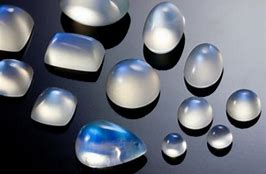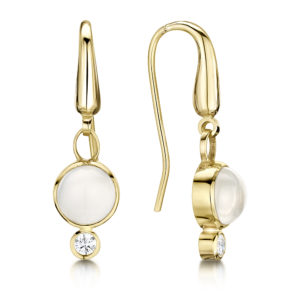

Moonstone Key Facts
- 6 on the Mohs scale of hardness
- February’s birthstone
- A beautiful translucent stone that comes in many colours
- The best moonstone called ‘blue moonstone’ is mined in Burma and Sri Lanka
- Said to soothe and balance the emotions
General Information on Moonstone
Considered a Birthstone for February, moonstone belongs to the mineral family of Feldspar, which provide almost two thirds of stones on the earth. However, only a small percentage of feldspars fall into the ‘gem quality’ range.
Moonstone is made up of many layers. Light enters the stone and refracts among the layers before leaving the stone. The sheen effect, which is called schiller or adularescence, is caused by the intergrowth of 2 different types of feldspar, orthoclase and albite, with different refractive indexes. These intergrowths result from compatible chemistries at high temperatures becoming incompatible at lower temperatures creating a separating and layering of the 2 phases when the stone cools down.
Rainbow moonstone is part of the labradorite feldspar.
Feldspar can be found in many locations throughout the world. The finest blue moonstones can be found in Mogok, Burma (Myanmar). Most of the traditional mines in Sri Lanka are now closed. Moonstone can also be found in Madagasgar, India and Brazil.
Moonstone has a hardness rating of 6. Although reasonably tough, it can be fragile so should be handled with care. Small damages can arise after long periods of being worn, however it is possible for these to be polished away. This must be considered when choosing to commission a bespoke moonstone engagement ring from us.
Moonstone comes in a variety of colours including white, grey, brown, yellow, green, pink, blue. Some moonstones will have an eye as well as a sheen.
The clarity of a moonstone can range from transparent to translucent. Moonstones can contain inclusions, which appear to be tress cracks.
There is no treatment known which enhances moonstone quality.

